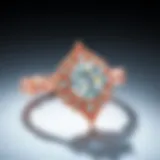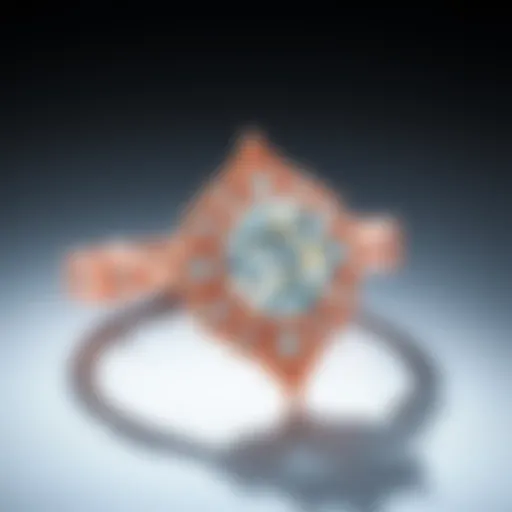Exploring the Unique Beauty of Australian Teal Sapphire
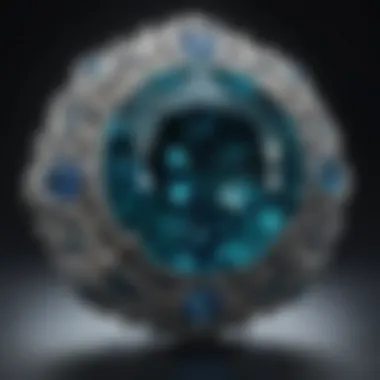

Intro
Australian teal sapphire is an extraordinary gemstone, captivating both enthusiasts and collectors alike. Its distinct hue, a blend of blue and green, sets it apart in the vast range of sapphires available today. As we delve into this guide, we will explore its origins, properties, and significance. Understanding this gem is vital for both appreciation and optimal care.
Gemstone Overview
Description of the gemstone
Teal sapphire is celebrated for its unique color, which varies from a deep, rich blue to a lighter, more vibrant green. This particular variety is primarily sourced from Australia, where geological conditions have created an ideal environment for their formation. Unlike common blue sapphires, the teal variety displays a more complex color palette, often attracting those seeking something different.
Physical properties
Teal sapphires are known for their durability, ranking 9 on the Mohs scale of hardness. This makes them suitable for everyday wear in various types of jewelry. The gemstone exhibits excellent clarity and brilliance, enhanced by its unique hue. Additionally, it displays pleochroism, meaning it can appear to change colors when viewed from different angles. This property adds to its visual interest and allure.
Healing Properties
Metaphysical attributes
Many believe teal sapphires possess powerful metaphysical properties. They are thought to promote calmness and tranquility, aiding in emotional healing. It is said that this stone helps to enhance intuition, making it popular among those engaged in spiritual practices. Those who wear the gemstone reportedly experience increased clarity of thought and a greater connection to their inner self.
Common uses in holistic practices
In holistic practices, teal sapphires are often used in meditation and healing rituals. Here are some common applications:
- Meditation: Placing a teal sapphire nearby during meditation can foster a deeper sense of peace.
- Crystal grids: Many use these gems in layouts aimed at balancing energy.
- Jewelry: Wearing teal sapphire jewelry is believed to provide ongoing emotional support and grounding.
"Teal sapphires not only adorn but also serve as powerful tools for emotional and spiritual growth."
Closure
Teal sapphires from Australia offer more than just beauty; they provide a rich history, unique physical characteristics, and potential healing properties. Understanding these aspects is essential for those interested in this gemstone, whether for personal use or as part of a collection. As we conclude this guide, we hope you feel inspired to explore and appreciate the captivating qualities of teal sapphires.
Intro to Australian Teal Sapphire
Australian teal sapphire has emerged as a captivating gemstone that piques the interest of collectors, jewelry designers, and gemstone enthusiasts alike. Its distinct hue, which serves as a bridge between blue and green, offers a unique aesthetic that sets it apart from other sapphires. The allure of this gem is not just in its color, but also in its origins, properties, and the cultural significance that envelops it.
Understanding the origins and composition of teal sapphire is essential for anyone looking to appreciate its beauty and invest in it. The article will delve into various aspects of this gemstone. This includes defining its color variations, exploring geological formations, and examining its physical properties. Additionally, we will highlight how these elements contribute to the gem's market value and its standing among other precious stones.
The importance of this exploration extends beyond mere aesthetics. Teal sapphire represents a commitment to quality and authenticity, especially in the batch of gemstones available today. By discussing the factors that influence their pricing and the ethical considerations involved in their sourcing, readers gain a well-rounded view of the teal sapphire's place in the gemstone market.
Moreover, this guide addresses the cultural significance of teal sapphire, which can enhance its sentimental value. From its historical context to its symbolism in different cultures, knowing the narrative behind this gemstone enriches the experience of owning or gifting it.
In summary, Australian teal sapphire is more than a striking gemstone; it is a blend of geological charm, cultural history, and market dynamics. This guide aims to provide an in-depth understanding of teal sapphire, assisting readers in making informed decisions whether they are collectors, designers, or simply enthusiasts.
Defining Teal Sapphire
Understanding teal sapphire is vital for anyone interested in gemstones, especially for enthusiasts and collectors. This section provides clarity on what teal sapphire represents, its unique characteristics, and how it differentiates itself from other sapphires.
Color Variations
Teal sapphire exhibits a rich and alluring blend of blue and green hues. The intensity of these colors can vary widely, leading to various shades that appeal to different preferences. Factors influencing color include the mineral composition and the environment in which the sapphire formed. Some teal sapphires may lean more towards a blue tone, while others can appear predominantly green. The intricate balance of these colors contributes significantly to the stone's allure.
Additionally, the presence of trace elements such as iron and chromium can alter the saturation and vibrancy of teal hues. For instance, a higher concentration of iron can yield a darker shade, whereas chromium can produce brighter, more vivid colorations. Understanding these dynamics helps collectors and jewelry designers make informed choices when selecting gems for their collections or creations.
Comparison with Other Sapphires
Teal sapphire stands out not only due to its unique color but also when compared to other types of sapphires, such as blue, yellow, and pink. Blue sapphires, particularly those from Sri Lanka or Kashmir, often exhibit a deep blue primarily without the green undertones characteristic of teal sapphires. On the other hand, yellow sapphires show a warm hue, making them distinctively different.
Moreover, teal sapphire can be confused with other similar stones, like tourmaline or certain zircon varieties. Each gemstone has unique attributes. Understanding these differences helps in evaluating authenticity, value, and suitability for jewelry design.
"Teal sapphire’s unique blend of colors makes it a truly remarkable choice for jewelry, offering versatility in design while retaining distinctiveness."
Origin of Australian Teal Sapphire
The origin of Australian teal sapphire is crucial in understanding not just the gem's quality, but also its appeal in the global market. Teal sapphires possess a distinctive hue that varies from shades of blue to green, making them unique among sapphires. Recognizing where these stones come from also provides insight into their formation processes, which contribute to their lasting appeal for both collectors and jewelry enthusiasts. The geology of the area plays a significant role in shaping the characteristics of these gemstones, affecting everything from their color to their clarity.
Geological Formation
Australian teal sapphires have a fascinating geological formation history that starts millions of years ago. These sapphires are formed through a complex process involving heat and pressure. The parent rock, typically igneous or metamorphic, undergoes a metamorphosis that leads to crystallization of aluminum oxide with trace amounts of elements like iron and titanium, which gives teal sapphires their distinctive color.
The presence of iron in specific oxidation states can shift the color from blue to green, resulting in the vibrant tones found in teal sapphires. It's important to recognize that not all sapphire deposits are created equally. The specific geological conditions in Australia, including the unique mineral compositions and specific environmental factors, contribute to the exceptional quality of these stones.
As a result, teal sapphires from Australia are considered among the finest in the world, both in aesthetics and durability.
The significance of their formation extends beyond appearance. The geological stability of the region aids in preserving these stones, enhancing their longevity for future generations. This geological backdrop is essential for anyone interested in the natural history of gemstones, particularly in how physical conditions influence mineral growth.
Major Mining Locations
When it comes to mining Australian teal sapphires, several key locations stand out. The most notable among these is the state of Queensland, particularly the area around the town of Sapphire. This region is renowned for its rich sapphire deposits and has been a significant site for sapphire mining for decades. The history of sapphire mining in this region dates back to the late 19th century and continues to this day.
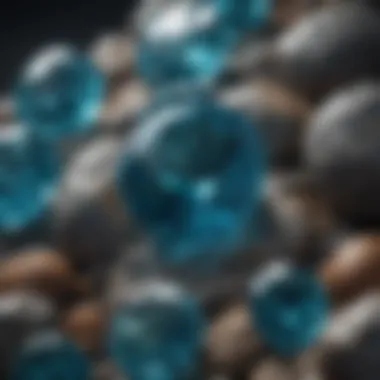

Aside from Queensland, New South Wales also has active sapphire mines, particularly in the area known as the New England region. These locations are not only vital to the economy but also provide job opportunities for local communities.
In addition to mining, the methods employed can impact the quality of gemstones harvested. Some miners adhere to sustainable practices, while others might use more destructive methods. This distinction can affect both the gem's properties and its ethical standing in the marketplace.
End
The origin of Australian teal sapphires is not only a matter of location but also involves deeper geological elements and mining practices. Understanding these aspects provides a comprehensive perspective on why these gemstones hold great value and appeal. Through geological formation and insights into major mining locations, one gains a more profound appreciation for the distinguished qualities of Australian teal sapphire.
Physical Properties of Teal Sapphire
The physical properties of teal sapphire are crucial for understanding its value and appeal. These properties encompass the gemstone's durability, clarity, and overall aesthetic qualities. They provide buyers and collectors with insights into the quality and longevity of the stone. For any gemstone, including teal sapphires, these characteristics not only inform the market price but also influence the choices of jewelry designers and enthusiasts alike.
Hardness and Durability
Teal sapphires belong to the corundum mineral family, which boasts a remarkable hardness rating of 9 on the Mohs scale. This places it just below diamonds, making it an incredibly durable choice for various types of jewelry. Its hardness means it is resistant to scratches and abrasions, ensuring that pieces set with teal sapphire maintain their luster and beauty over time. The high durability of teal sapphire makes it a preferred choice for everyday wear, particularly in rings and bracelets.
However, it is essential to note that while the hardness of teal sapphire provides strength, care should still be taken to avoid hard impacts that could lead to chipping or breaking. Regular inspections can help in spotting any issues early, preserving the integrity of the stone.
Clarity and Inclusions
Clarity is another significant aspect of teal sapphire evaluation. High-quality teal sapphires exhibit excellent clarity, showing minimal inclusions or imperfections. These internal characteristics can affect the stone’s beauty and brilliance. Clarity is often classified into grades ranging from flawless to included, with inclusions generally decreasing the stone's value.
Some inclusions can create unique visual patterns that enhance the charm of teal sapphires. Each stone tells its own story through its internal features. Professional gemologists use tools such as a loupe or microscope to assess inclusions accurately. Successfully navigating clarity assessments enables collectors to understand better the quality of the sapphire they are considering.
Cut and Shape
The cut and shape of a teal sapphire play vital roles in its overall appearance and marketability. A well-executed cut can enhance the gem's brilliance and reflect light in captivating ways. Common shapes for teal sapphires include oval, cushion, round, and pear shapes, each catering to different aesthetic preferences in jewelry design.
When evaluating the cut of a teal sapphire, factors to consider include:
- Proportions: How well the angles and dimensions align.
- Symmetry: The uniformity across the gemstone contributes significantly to its overall appeal.
- Finish: Surface quality is vital; a well-polished surface enhances brilliance.
A well-cut teal sapphire not only looks visually stunning but also impacts its perceived value. Buyers should pay special attention to these aspects when selecting a gemstone for investment or personal use.
Proper attention to the physical properties of teal sapphire ensures a prudent investment in an enduring gem.
Value and Pricing of Teal Sapphire
Understanding the value and pricing of Australian teal sapphire is crucial for both collectors and industry professionals. This section breaks down specific elements that impact the price of this gemstone, offering insights into the nuances that can affect its market value. By examining the factors that influence price, readers can make informed decisions about purchasing or investing in teal sapphires. Additionally, being aware of market trends is essential for those interested in jewelry design or gem collecting.
Factors Influencing Price
The price of Australian teal sapphire is determined by various factors, making it important for buyers to recognize what affects the valuation. Some key aspects include:
- Color Quality: The intensity and saturation of the teal color play a significant role in determining value. Stones that exhibit a vibrant and evenly distributed hue are generally more sought after.
- Clarity: Higher clarity stones, with few or no visible inclusions, command higher prices. Buyers often prefer stones that appear exceptionally clear to the naked eye.
- Cut Quality: The skill of the gem cutter can dramatically affect the visual appeal of a sapphire. Well-cut stones reflect light effectively, enhancing brilliance and overall appearance.
- Size: Larger gemstones can be quite valuable. This is due to their rarity and the increased work involved in mining and cutting them.
- Origin: Sapphires from Australia are particularly valued because of their unique characteristics and perceived quality compared to sapphires from other regions.
These factors work together to determine the market price, often varying by individual preferences and market demand.
Market Trends
Market trends in the teal sapphire space can shift based on various influences—from consumer behavior to global economic conditions. Presently, several noticeable trends are impacting how these sapphires are valued in the jewelry industry:
- Sustainability Appeal: There is a growing interest in ethically sourced gemstones. Buyers are increasingly prioritizing the origin, favoring stones that come from sustainable mining operations. This desire can drive prices higher for responsibly sourced teal sapphires.
- Fashion Influences: Jewelry designers often dictate market trends. The increasing use of teal sapphire in modern jewelry, such as engagement rings and statement pieces, has led to a surge in demand.
- Investment Potential: As Australian teal sapphires gain recognition, more investors are looking at them as asset investments. This trend impacts pricing, often leading to auction prices that exceed typical retail values.
- Digital Platforms: Online marketplaces and social media shing platforms have made it easier for collectors and consumers to access information about availability and pricing. This increased visibility influences market demand and can drive up prices based on competition.
"The allure of Australian teal sapphire is not just in its beauty, but in the evolving dynamics of its market and demand."
Cultural Significance
The cultural significance of Australian teal sapphire extends beyond its physical beauty. It plays a vital role in various traditions and practices, enriching the understanding of both the gemstone and its place in society. From ancient histories to modern uses in personal adornment, the cultural elements associated with teal sapphire are manifold.
Historical Context
Australian teal sapphire has a fascinating history tied deeply to the indigenous cultures of Australia. Historically, gemstones have been valued not just for their aesthetics, but also for their metaphysical properties. Aboriginal people recognize the importance of natural materials in every aspect of life, including jewelry making. This gemstone, with its unique hue, has adorned various artifacts and ceremonial items, serving as a symbol of wealth and connection to the land.
As Australia developed and began exporting gemstones, teal sapphire gained recognition in global markets. Its distinctive color and rarity contributed to its appeal among collectors and jewelers. The demand for Australian sapphires increased significantly in the late 20th century, integrating this gemstone into both modern jewelry and traditional craftsmanship. The history encompasses trends in mining, trade, and the evolving perception of gemstones across cultures.
Symbolism in Different Cultures
Teal sapphires carry various meanings, depending on the culture in question. Common symbols associated with this gemstone often include tranquility, wisdom, and protection. In many Eastern cultures, sapphires are believed to bring good fortune and are often incorporated into religious artifacts.
- Western Cultures: In these settings, teal sapphire signifies special milestones. It's common to see it in engagement rings and anniversary gifts, showing commitment and loyalty in personal relationships.
- Eastern Cultures: There is a belief that teal sapphires can enhance meditation and spiritual insight. They are often used during spiritual rituals and are thought to help open pathways to higher consciousness.
- Indigenous Australian Cultures: For Aboriginal people, the gemstone is more than a luxury item. It represents a connection to ancestral land and the rich history of Australia, embodying the essence of natural beauty and heritage.
This interplay between the teal sapphire and culture offers a rich tapestry showcasing its significance across the world. Appreciation for this gemstone goes beyond physical characteristics and embraces its role in society and individual expression. Through understanding these cultural dimensions, one can grasp the full impact of Australian teal sapphire in both historical and contemporary contexts.
"Gemstones are not just beauty; they are a bridge to our past and a guide to our future."
Uses in Jewelry Design
Australian teal sapphire has become a prominent choice in jewelry design. Its unique color, durability, and versatility make it suitable for various types of jewelry pieces. Jewelry designers appreciate not only the gemstone's beauty but also its ability to enhance the overall design of a piece. This section will explore the significance of teal sapphires in jewelry and the specific types commonly used.
Popular Jewelry Types


- Rings: Teal sapphires are often set in engagement rings. Their distinctive hue provides a modern alternative to traditional white diamonds, allowing couples to express their individuality. The gemstone’s durability, rated at 9 on the Mohs scale, ensures a lasting piece that can withstand daily wear.
- Necklaces: Many designers use teal sapphires as the centerpiece in necklaces or pendants. Their vibrant color contrasts beautifully with various metals, creating striking focal points that attract attention.
- Earrings: Teal sapphire earrings, both studs and drop styles, add a splash of color to everyday wear. Designers often pair them with other colored gemstones or diamonds to create unique combinations.
- Bracelets: In bracelet designs, teal sapphires can be used as accents or as part of a broader theme. Their varied shades can complement other stones or provide a pleasing balance within a colorful design.
These applications show how versatile teal sapphires are in the realm of jewelry design. They appeal to diverse tastes, from contemporary to classic styles.
Trends in Modern Jewelry
Teal sapphires are currently trending in the jewelry market. Their distinctive hue, often described as a mix of blue and green, fits well with current color trends that favor bold and unconventional choices.
- Mixing Materials: Designers now increasingly combine teal sapphires with both traditional metals like gold and silver, as well as alternative materials like resin and wood. This mixing adds depth and a modern twist to the design.
- Customization: There is a growing trend for personalized jewelry pieces. Teal sapphires are often included in bespoke designs as they allow individuals to showcase their style and love for unique gems.
- Eco-Friendly Designs: With the rise of ethical jewelry, many designers are opting for sustainably sourced teal sapphires. Consumers are becoming more aware of the environmental and ethical implications of their purchases. This trend is translating into designs that reflect individual values.
Overall, the use of Australian teal sapphire in jewelry design is expanding and evolving. Its unique characteristics not only enhance the aesthetics but also connect deeply with emerging market trends.
Care and Maintenance
Caring for Australian teal sapphire is essential to maintain its beauty and value. Proper maintenance ensures that the gemstone remains vibrant and free from damage. It is easy to overlook the care needed for these gems, but understanding the best practices is invaluable for any enthusiast or owner. Here, we explore detailed cleaning techniques and storage guidelines that will help protect your teal sapphire.
Cleaning Techniques
Cleaning your teal sapphire regularly will remove dirt and oil that accumulate on the surface. Here are methods for effective cleaning:
- Gentle Soap and Water: Mix a few drops of mild dish soap with lukewarm water. Soak the sapphire for a few minutes, then use a soft brush, like a toothbrush, to gently scrub the stone. Rinse with clean water and dry with a soft cloth.
- Ultrasonic Cleaners: If your teal sapphire is set in jewelry, using an ultrasonic cleaner can be effective. However, caution is needed, as this might not be suitable for all types of gemstones. Always check if the sapphire can withstand ultrasonic cleaning.
- Avoid Harsh Chemicals: Steer clear from using bleach or ammonia-based cleaners. These harsh chemicals can damage the stone and its setting.
While cleaning is critical, it should be done gently to prevent scratching or damaging the sapphire.
Storage Guidelines
Proper storage of teal sapphire is vital to keep it in excellent condition. Here are some best practices for storing your gemstones:
- Separate from Other Jewelry: Store teal sapphires away from other pieces to prevent scratching. Use a dedicated pouch or a soft-lined jewelry box.
- Avoid Excessive Heat or Humidity: Teal sapphires are relatively durable, but extreme conditions can affect their color and luster. Keep them in a stable environment that avoids direct sunlight.
- Use Individual Compartments: If using a jewelry box, consider compartments for each item. This keeps sapphires secure and eliminates any risk of contact with harder gemstones, which can cause scratches.
Proper care can significantly extend the life of your teal sapphire, preserving both its beauty and its value over time.
By following these cleaning techniques and storage guidelines, you can ensure that your Australian teal sapphire remains a cherished part of your collection.
Metaphysical Properties
The metaphysical properties of Australian teal sapphire merit attention due to their historical and contemporary significance. In various cultures, gemstones are believed to hold unique energies that can influence the mind, body, and spirit. This section explores the specific healing attributes and spiritual significance attributed to teal sapphires, shedding light on the benefits that enthusiasts often seek.
Healing Attributes
Australian teal sapphire is often associated with healing energies. Many believe it promotes emotional stability and mental clarity. When individuals use this gemstone, they may find it eases anxiety and calms turbulent thoughts. The stone is thought to enhance communication, making it easier for one to articulate feelings and reduce misunderstandings in conversations.
In addition to emotional healing, some users report physical health benefits. Teal sapphire is believed to support the respiratory system and improve overall vitality. By fostering a sense of well-being, it encourages individuals to pursue a balanced lifestyle, which aligns with many wellness practices today.
"Gemstones can provide subtle yet impactful benefits to one's mental and physical state, especially in the case of teal sapphire."
Spiritual Significance
Beyond healing, teal sapphire has deep spiritual meanings. Many consider this gemstone as a conduit to higher wisdom and insight. It is believed to connect individuals with their inner selves and the universe's energies. Those who meditate with teal sapphire report enhanced intuition and a stronger connection to their spiritual guides.
Furthermore, teal sapphire is often associated with the element of water, representing reflection and emotional depth. This connection encourages individuals to explore their feelings and gain insights into personal experiences. In spiritual practices, it is revered for its potential to facilitate personal growth and transformation.
To summarize, understanding the metaphysical properties of Australian teal sapphire allows collectors and enthusiasts to appreciate not only its beauty but also its potential impact on overall well-being and spiritual journeys.
Environmental and Ethical Considerations
The discussion of Australian teal sapphire cannot ignore the crucial aspects of environmental and ethical considerations. In recent years, consumers have become increasingly aware of the impact of mining practices on the environment and local communities. This heightened awareness drives demand for transparency in the sourcing of gemstones. For teal sapphire, understanding the implications of mining and sourcing is essential for both ethical consumers and investors. Each decision made in the process of mining and purchasing teal sapphires can effect not only the gem's value but also the local ecosystem and populations.
When choosing to invest in or wear a teal sapphire, individuals should consider how their choices align with sustainable practices. Recognizing the importance of responsible mining and ethical sourcing can positively impact the market for teal sapphire and the overall gemstones industry.
Sustainable Mining Practices
Sustainable mining practices refer to methods that aim to minimize environmental damage during the extraction of gemstones from the earth. In Australia, certain companies have adopted measures to ensure their mining processes are not only efficient but also environmentally friendly.
Improved techniques such as selective mining, which reduces waste, and rehabilitation efforts that restore mined land, are becoming more common. By utilizing these practices, miners seek to lessen their carbon footprint and promote biodiversity in affected areas. Furthermore, some operations are investing in renewable energy to power their equipment, demonstrating a commitment to reducing fossil fuel reliance.
These practices benefit not just the environment, but also improve the public perception of the teal sapphire industry. When buyers can be confident in the sustainability of their gemstone’s origin, they are more likely to invest in these stones, creating a positive feedback loop towards continued sustainable practices in mining.
Ethical Sourcing
Ethical sourcing of teal sapphire focuses on ensuring the gemstones are obtained in a manner that respects human rights and labor ethics. This can include the treatment of workers, fair wages, and the overall impact of mining operations on local communities.
Gemstone retailers are now prioritizing partnerships with suppliers who follow ethical guidelines. Certifications from recognized organizations can help verify whether a teal sapphire has been sourced responsibly. Buyers should ask about the supply chain and strive to purchase stones with documented histories.
By supporting ethical sourcing, consumers encourage more gem sellers to adopt similar practices. This shift can lead to a significant change in how gemstones are mined and distributed, promoting a culture that respects both the environment and the communities involved in the mining processes.
The move towards sustainable and ethical practices reflects a growing desire among consumers to ensure their investments align with their values.
Identifying Authentic Australian Teal Sapphire
Identifying authentic Australian teal sapphire is essential for anyone interested in gemstones, whether for personal enjoyment or investment. The inherent value and allure of this gemstone can be compromised if one does not recognize its authentic characteristics. In the world of gemstones, discerning the genuine from the counterfeit is critical for making sound purchasing decisions.
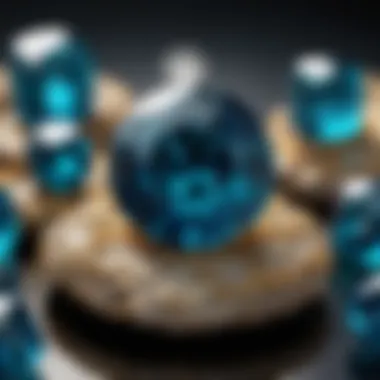

Certification and Appraisal
When acquiring a teal sapphire, obtaining a professional certification is paramount. A gemological laboratory offers certifications that verify a sapphire's type and authenticity. Organizations like the Gemological Institute of America (GIA) provide detailed reports analyzing various attributes, including color, clarity, cut, and carat weight.
A certified teal sapphire carries more trust in the market. Buyers can rely on an expert's assessment rather than relying solely on the seller's claims. The significance of this documentation extends beyond merely proving authenticity; it can also affect resale value.
- Importance of Certification
- Types of Certifications
- Ensures gemstone is genuine
- Evaluates quality and characteristics
- Influences resale potential
- GIA (Gemological Institute of America)
- AGL (American Gemological Laboratories)
- EGL (European Gemological Laboratory)
Appraising a gemstone further provides insights into its value and condition. Knowing the fair market price can prevent overpayment and guide potential future investment.
Common Counterfeits
Various counterfeit methods exist, making it essential to understand them. Some fake teal sapphires may appear visually similar but lack the same qualities as genuine stones. Being aware of these counterfeits enables buyers to avoid costly mistakes.
- Synthetic Sapphire
- Treated Stones
- Imitations
- Lab-created versions which might look similar but differ chemically
- Genuine sapphires treated to enhance color or clarity may mislead buyers if not disclosed
- Different materials like glass or cubic zirconia designed to mimic appearance
The differences between authentic and counterfeit stones can often include aspect such as light refraction and hardness. For instance, authentic teal sapphire ranks a 9 on the Mohs scale, making it durable and resistant to scratches. In contrast, many imitators are softer and more prone to damage.
"Authenticity in teal sapphire is not merely aesthetic; it reflects the integrity of the gemstone market."
Investment Potential
Investment potential in Australian teal sapphire reflects its worth not only as a gemstone but also as a financial asset. This section fosters awareness among gemstone enthusiasts about why investing in teal sapphire is a sound choice. Various factors influence this aspect, including the rarity, demand, and overall market dynamics.
Market Performance
The current market performance of Australian teal sapphire positions it favorably in the gemstone investment landscape. The demand for colored gemstones has surged, attributed to their unique appeal and investment viability. Over the last decade, teal sapphires have witnessed steady growth in value, outperforming many traditional investment avenues. Their exquisite hue, marrying shades of blue and green, captures the attention of both collectors and jewelry designers alike.
A few elements contribute to its positive market performance:
- Rarity: Teal sapphires are less common compared to other sapphires, such as blue or yellow. Their scarcity often drives prices higher.
- Quality Variations: High-quality stones with excellent cut, clarity, and vibrant color can command significant premiums.
- Emerging Markets: Increased interest from global markets, particularly in Asia, plays a significant role in sustaining demand.
As the market continues to evolve, investors should monitor these trends closely to make informed decisions.
Future Trends
Looking ahead, the future trends for Australian teal sapphire appear promising. Analysts anticipate continued growth in both demand and value, backed by evolving consumer preferences. The rise of eco-conscious buying behavior is likely to influence many buyers' choices, making ethically sourced and sustainable products increasingly appealing.
Factors shaping future trends include:
- Increased Awareness: Enhanced education about gemstones and their characteristics may lead to a larger audience appreciating the value of teal sapphire.
- Innovative Designs: Jewelry designers are increasingly incorporating teal sapphire in collections, which may further drive demand.
- Investment Diversification: Investors seeking to diversify their portfolios may turn to colored gemstones, boosting teal sapphire's profile.
"Investment in gemstones like teal sapphire is not only about beauty but also about understanding market trends and consumer preferences."
Culmination
The conclusion of this guide serves as a crucial element, synthesizing insights gathered regarding Australian teal sapphire. It encapsulates the knowledge about its distinct color, geological origins, and significance in both cultural and modern jewelry contexts. Understanding these dimensions enhances the appreciation for this unique gemstone, allowing potential buyers, collectors, and enthusiasts to make informed decisions.
This article provided key factors influencing the valuation and pricing of teal sapphire. Being aware of market trends and ethical considerations, such as sustainable mining practices, equips interested parties with the tools to navigate the gemstone market responsibly. The growing demand for ethically sourced stones necessitates an understanding of the sourcing practices utilized within the industry.
Furthermore, the comprehensive look into care and maintenance reinforces the importance of protecting an investment. Proper care not only preserves beauty but also extends the lifespan of these remarkable gemstones.
In summary, Australian teal sapphire is more than just a visually striking gem; it embodies rich hues, cultural stories, and significant economic implications. Its allure continues to captivate, making it essential for enthusiasts and investors alike to stay informed and knowledgeable about all its facets.
Final Thoughts
As we finish exploring the multifaceted world of Australian teal sapphire, it becomes evident that this gemstone holds both aesthetic and cultural value. The intricate details regarding its origins, properties, and applications in jewelry design demonstrate its significance in today’s market. For those looking to invest or simply appreciate the beauty of teal sapphire, understanding its history and uniqueness adds depth to their experience. Venturing forward with this knowledge, one can develop a deeper respect for the complexity and allure of this captivating stone.
"Knowledge of gemstones is not just about their physical properties; it is about the stories they tell and the connections they foster."
Importance
References enrich the content by confirming statements and claims made throughout the article. They inform readers about where to find additional information or validate what has been shared. For gemstone enthusiasts, collectors, and jewelry designers, knowing that the insights provided are derived from established sources enhances the value of the article. It establishes trust and invites the reader to investigate further.
Specific Elements
- Credibility: A well-researched article cites sources like academic journals, gemological institutions, and recognized experts in the field.
- Depth: References can guide readers to studies that delve deeper into topics such as the geological formation of teal sapphire, its market trends, or its metaphysical properties.
- Connections: They link to broader discussions on gems and minerals, allowing readers to understand the context around teal sapphires better.
Benefits of Using References
- Validation: Supports the accuracy of claims made in the article.
- Resource Expansion: Encourages readers to explore beyond the article, fostering a deeper understanding.
- Expert Opinions: Many readers appreciate insights from recognized authorities in the gemstone field.
- Continuous Learning: Readers interested in geology or jewelry design can follow references for advanced knowledge.
Considerations
When citing references, it is crucial to ensure that the sources are current and relevant. Information about gemstones, mining practices, and market trends evolve continually. Therefore, up-to-date references will ensure that readers receive the most accurate and timely insights. Furthermore, linking to resources that readers can easily access, such as Wikipedia, Britannica, and relevant forums like Reddit, can foster engagement and further inquiry.
A strong set of references not only supports the narrative but also empowers readers to embark on their research journey, enriching the overall experience of learning about Australian teal sapphire.


